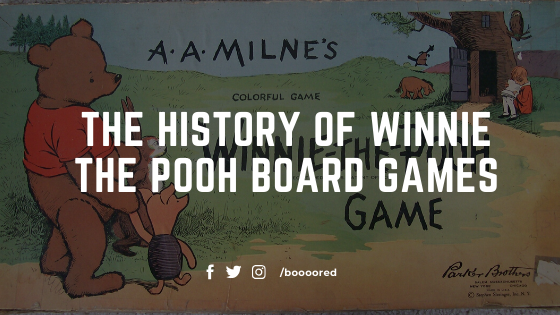Today is National Winnie the Pooh Day that commemorates author A.A. Milne’s birthday in 1882. He brought the adorable, honey-loving bear to life in his stories, which also featured his son, Christopher Robin.
To Celebrate Winnie the Pooh Day we want to take a moment to explore the history of Winnie the Pooh Board Games even tho this Franchise being created in Board Game format has only happened a couple of times lets look at the Winnie the Pooh Board Games to be released since its inception in 1926.
1933 – Winnie the Pooh
The First time Winnie the Pooh found himself featured in a board game was in 1933.

The board game plays much like the familiar game of Candy Land designed in 1948 by Eleanor Abbott and then published by Milton Bradley in 1949. Movement along the game board is determined by the drawing of colours. Coloured discs are pulled from a ‘grab bag’ though, which is unlike the drawing of coloured cards and movement in Candyland.
The rules for playing Winnie-the-Pooh state the method for advancing a player’s piece to the next colour drawn “is entirely new and in a simple manner”. The game was obviously aimed towards a market of young children.
Some have suggested that the creation of the game may have been the Parker Brothers attempt to invent a game which would rival the popular children’s Milton Bradley game of Uncle Wiggily of the time with Uncle Wiggily latter getting replaced with Candyland as the company’s most successful game.
The Game was then Republished with new artwork up until 1979 staying in the Parker Brothers Family
- Winnie the Pooh Game ‐ Third edition (1979)
- Publisher: Parker Brothers
- Winnie the Pooh Game ‐ Third edition (1979)
- Publisher: Parker Brothers
- Nalle Puh ‐ Alga Swedish edition (1965)
- Publisher: Alga
- Winnie the Pooh ‐ Parker Brothers edition 1964
- Publisher: Parker Brothers
- Winnie the Pooh ‐ Parker Brothers edition 1958
- Publisher: Parker Brothers
- Winnie the Pooh Game ‐ Parker first edition (1933)
- Publisher: Parker Brothers
1964 – Winnie the Pooh Honey Tree Game
The next game to be published was the classic Winnie the Pooh and the Honey Tree Game this game was initiated by the team at Disney and still had its latest version published in 2003 this unique game involved cardboard and plastic elements with the most notable feature being the plastic honey tree.

Description from the Box
The bees have left the Honey Tree and are busy at work. Winnie-the-Pooh has climbed up the Tree and is filling himself with the honey that the busy bees have stored in their hive. His friends must save him by rushing to the Honey Tree to help him down before the bees return.”
Players move along a modular cardboard path which is assembled prior to gameplay, towards a plastic three-dimensional tree where Winnie The Pooh is stuck up a ladder. The path consists of colored squares; these colors correspond to cards which are drawn from a stack to determine the movement of each player.
Once a player reaches the tree they must drop a marble down a hole located in the top of the plastic structure; this may or may nor trigger the mechanism which causes Winnie to slide down the ladder, ending the game.
1990 – Winnie the Pooh Friends of the Forest Game
Winnie the Pooh did not make a significant traditional style board game again until 1990 when publisher Waddington’s Games, Inc. decided to create a game based on the franchise.
/pic187800.jpg)
Winnie the Pooh: Friends of the Forest Game is a game for ages 5+ for 2-4 Players where players are Down in the Hundred Acre Wood, with Pooh and his friends who have fallen on hard times.
The once crystal blue river has long since clogged up with rubbish and the trees which provide warmth and shelter for the animals are fast disappearing.
Woozles and Heffalumps are mischievous creatures, who wreak havoc in the wood chopping down trees, tossing rubbish in the river and generally making a nuisance of themselves. Your task is to help Pooh clean the river and plant three trees.
Players would roll a die and move around the board planting trees and cleaning river sections. When a player lands on a Spin the cloud space the weather cloud is spun and effects are applied to the player’s areas
Sunny – Take a tree
Stormy – Lose a tree but clean a river section
Pollution – Lose a tree and a clean river section
Gloomy – Your area is unaffected
Trees and Rivers can also be lost and gained through cards and other board spaces.
This game only received one version and was never republished
1990 – Winnie the Pooh: Join Pooh and friends in the 100-acre wood
1990 was also the introduction of Winnie the Pooh: Join Pooh and friends in the 100-acre wood Milton Bradleys reentrance to the Winnie the Pooh board game publishing world.
/pic515767.jpg)
The game feels a lot like a return to its original 1933 edition with the inclusion of the Candland style spinner as a player they were tasked to be the first to collect all the tokens which match the spaces on their house cards and get to Christopher Robin’s house.
Players like in Candyland would Spin the spinner to find out how far to move each turn.
/pic515769.jpg)
What’s Next
What board game is next for this franchise that’s been popular with kids and adults alike since 1926, when A.A. Milne first published the memorable story entitled Winnie-the-Pooh. The book contained the wonderful tales about the Hundred Acre Wood, Christopher Robin and his animal friends, including Winnie-the-Pooh. Who knows but we look forward to seeing what’s next.

